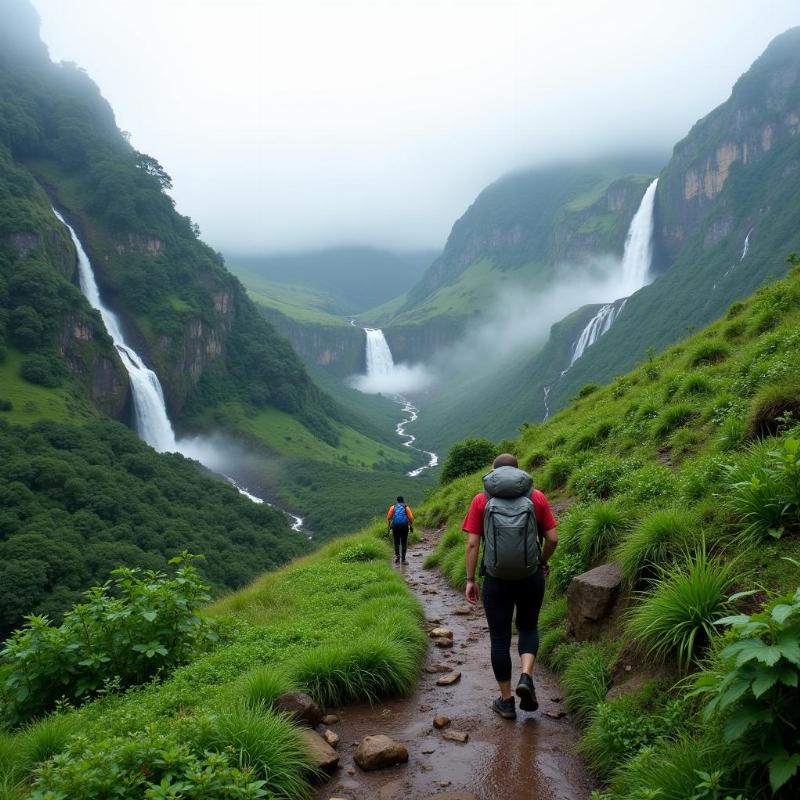The Rudranath trek, nestled in the Garhwal Himalayas of Uttarakhand, India, is a challenging yet rewarding pilgrimage. Choosing the right time for your Rudranath trek best time to visit is crucial for a safe and enjoyable experience. This guide will provide you with all the necessary information to plan your trek, covering the ideal seasons, weather conditions, what to pack, and other essential tips.
Understanding the Rudranath Trek Weather
The weather on the Rudranath trek can be unpredictable, varying significantly with altitude and season. Being prepared for these fluctuations is essential for a comfortable and safe journey.
Summer (May – June): Ideal for Trekking
Summer is considered the Rudranath trek best time to visit. The weather is generally pleasant with clear skies, offering stunning views of the surrounding peaks. Temperatures range from 10°C to 20°C during the day and can drop to around 5°C at night. This is peak season, so expect more trekkers on the trail.
Monsoon (July – September): Challenging but Rewarding
The monsoon season brings heavy rainfall, making the trek significantly more challenging. Trails become slippery, and the risk of landslides increases. However, the landscape transforms into a vibrant green paradise, offering a unique perspective. If you choose to trek during the monsoon, be prepared for wet conditions and exercise extreme caution.
 Lush greenery during monsoon season on the Rudranath Trek
Lush greenery during monsoon season on the Rudranath Trek
Autumn (October – November): Pleasant and Less Crowded
Autumn is another excellent time for the Rudranath trek. The monsoon rains subside, leaving behind crisp, clear air and breathtaking views. The temperature ranges from 5°C to 15°C, offering comfortable trekking conditions. This season is also less crowded than summer.
Winter (December – April): Closed for Trekking
The Rudranath trek is closed during winter due to heavy snowfall. The trails become impassable, and the extreme cold makes trekking dangerous.
What to Pack for Your Rudranath Trek
Regardless of when you choose to trek, packing the right gear is essential for a successful journey. Here’s a checklist:
- Layering Clothing: Pack layers of warm clothing, including fleece jackets, thermal underwear, and waterproof outerwear.
- Sturdy Trekking Shoes: Invest in good quality trekking shoes with ankle support.
- Backpack: A comfortable and spacious backpack is crucial for carrying all your essentials.
- Sleeping Bag: A warm sleeping bag is essential, especially if you’re camping.
- First-Aid Kit: Carry a comprehensive first-aid kit with essentials like bandages, antiseptic wipes, and pain relievers.
- Headlamp or Flashlight: A headlamp or flashlight is necessary for navigating in the dark.
- Trekking Poles: Trekking poles can provide extra stability and reduce strain on your knees.
Planning Your Rudranath Trek
- Fitness Level: The Rudranath trek is moderately challenging. Ensure you’re physically fit before embarking on the journey.
- Permits: Obtain the necessary permits for the trek.
- Guide and Porter: Hiring a local guide and porter is highly recommended, especially if you’re trekking during the monsoon or are not an experienced trekker.
- Accommodation: Accommodation options along the trek are limited to basic guesthouses and campsites. Book in advance, especially during peak season.
Conclusion
Choosing the Rudranath trek best time to visit requires careful consideration of the weather, your fitness level, and your preferences. Summer and autumn offer the most favorable conditions, while the monsoon presents a unique challenge. With adequate preparation and planning, the Rudranath trek promises an unforgettable experience in the heart of the Himalayas.
FAQ
- When is the best time to trek to Rudranath? Summer (May-June) and Autumn (October-November) are the best times.
- Is the Rudranath trek difficult? It’s moderately challenging and requires a good level of fitness.
- Do I need a permit for the Rudranath trek? Yes, permits are required.
- Can I trek to Rudranath during the monsoon? It’s possible, but challenging due to heavy rainfall. Exercise extreme caution.
- What kind of accommodation is available on the Rudranath trek? Basic guesthouses and campsites are available.